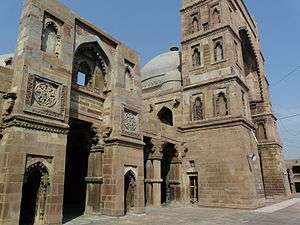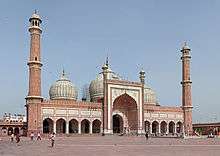Atala Mosque, Jaunpur
Atala Masjid or Atala Mosque is a 14th-century mosque in Jaunpur, Uttar Pradesh, India. It is one of the chief tourist attractions in Jaunpur.
| Atala Masjid | |
|---|---|
 | |
| Religion | |
| Affiliation | Islam |
| District | Jaunpur |
| Ecclesiastical or organizational status | Mosque |
| Location | |
| Location | |
| Territory | Uttar Pradesh |
| Geographic coordinates | 25°45′9″N 82°41′25″E |
| Architecture | |
| Type | Mosque |
| Style | Islamic, Sharqi architecture |
| Groundbreaking | 1377 (second) |
| Completed | 1155 (first), 1408 (second) |
| Demolished | 1364 |
It is located 2.2 km north-northeast of Jaunpur, 7.3 km northwest of Zafarābād, 16.8 km north-northeast of Mariāhū, 26.3 km west-northwest of Kirākat.[1]
Description
Atala Masjid was build by the destroyed remains of a hindu temple in old times and which is still visible in present structure[2] Atala Devi Temple was built by King Vijayachandra of the Gahadavala dynasty around 1155 A.D. Atala Devi is a Hindu goddess; She was believed to change fate, which is even unavoidable of inexorable fate.
Atala Devi Temple was destroyed by Ibrahim Naib Barbak, step brother of Sultan Firoz Shah Tughlaq III (1351–1388 CE).[3] Temple was demolished in 1364 CE, Ibrahim started construction in 1377 CE and completed the mosque in 1408 CE. Even Though, the outer structure is changed, the inner walls, pillars of this masjid have retained the original hindu temple structures.
A Madarsa named Madarsa Din Dunia is housed in central courtyard of the mosque. The Mosque is on the List of Monuments/Sites of Archaeological Survey of India of Directorate of Archaeology, (U.P.)[4] and on list List of Monuments of Archaeological Survey of India.[5]
William Hodges in his book Select Views in India mentions this mosque.[6]
The Gazetteer of Jaunpur district dated 1908 CE, written by H.R. Nevill, the district collector of Jaunpur, confirms the destruction and construction dates. According to the gazetteer, there stood an equally large temple of Mukatghat, built by Raja Vijaya Chandra of Kannauj, the father of Jayachandra/Jaichand (father-in-law of Prithviraj Chauhan).[7]
Architecture
The style of Atala Masjid's architecture is known as Sharqi Style. Even Though, the outer structure is changed, the inner walls, pillars of this masjid have retained the original hindu temple The impressive central dome almost 17 meters high above the ground can not be noticed from the front because of the presence of a tall tower (at 23 meters). See Image.
See also
- Shahi Bridge, Jaunpur
- Jama Masjid, Jaunpur
References
- ACME MApper
- https://m.dailyhunt.in/news/india/hindi/i+watch-epaper-iwatch/jaunapur+ka+jama+masjid+jo+kabhi+atala+devi+ka+mandir+huaa+karata+tha+use+ibrahim+nayib+barabak+ne+tod+diya+tha-newsid-79341030
- Archnet Digital Library: Atala Mosque Archived 9 May 2012 at the Wayback Machine
- Directorate of Archaeology (Uttar Pradesh): List of Monuments/Sites of archaeological survey of India Archived 13 June 2011 at the Wayback Machine
- "Archaeological Survey of India: Alphabetical List of Monuments - Uttar Pradesh". Archived from the original on 25 June 2009. Retrieved 31 July 2009.
- India a modern idők elött
- "Jama Masjid at Jaunpur was Atala Devi Temple - History". BooksFact - Ancient Knowledge & Wisdom. 25 October 2017. Retrieved 31 July 2018.
Sources
- Michell, George (ed). Architecture of the Islamic World: Its History and Social Meaning. London: Thames and Hudson, 272.
- Nath, R. 1978. History of Sultanate Architecture. New Delhi, Abhinav Publications, 98-100.
- Williams, John A. and Caroline. 1980. Architecture of Muslim India. Set 4: The Sultanate of Jaunpur about 1360-1480. Santa Barbara, California: Visual Education, Inc.
External links
| Wikimedia Commons has media related to Atala Masjid. |

